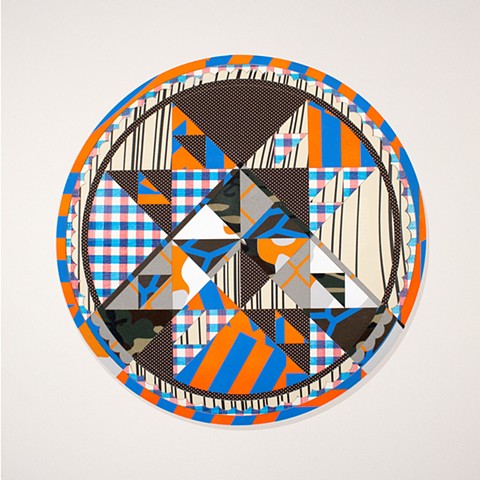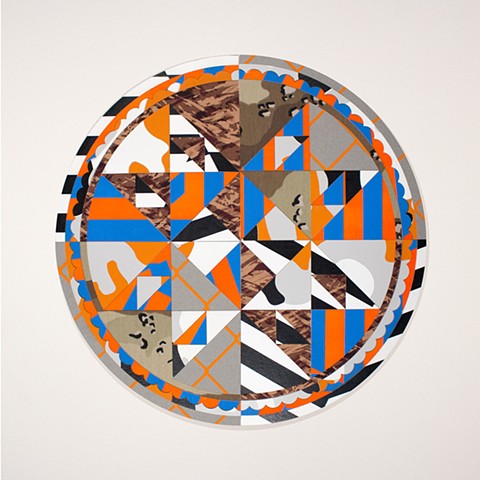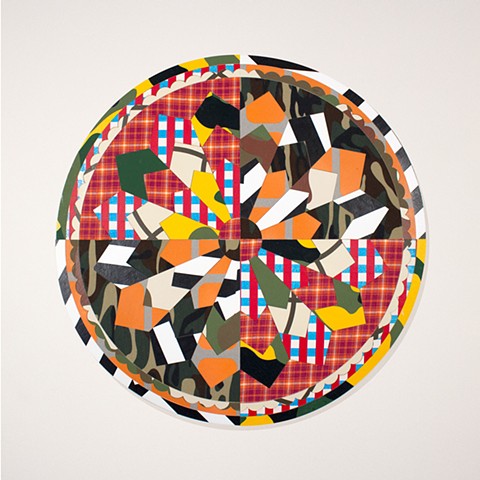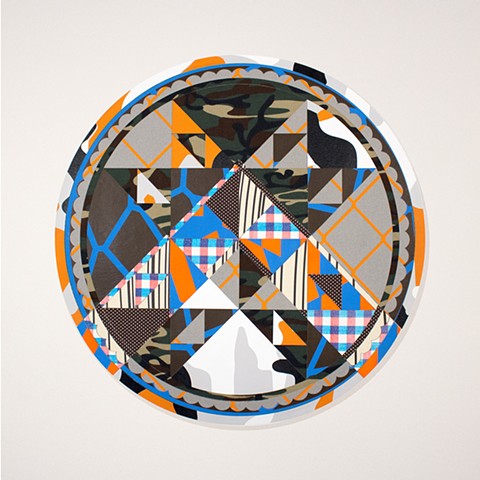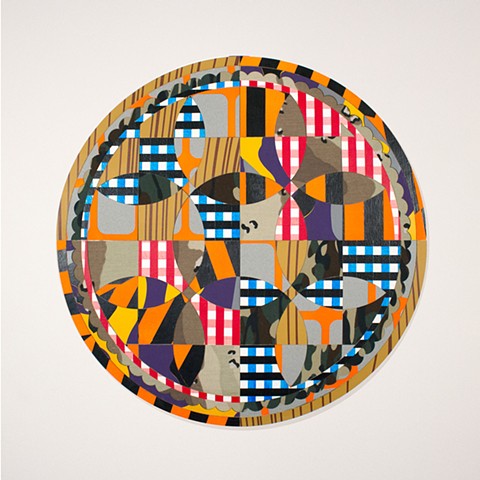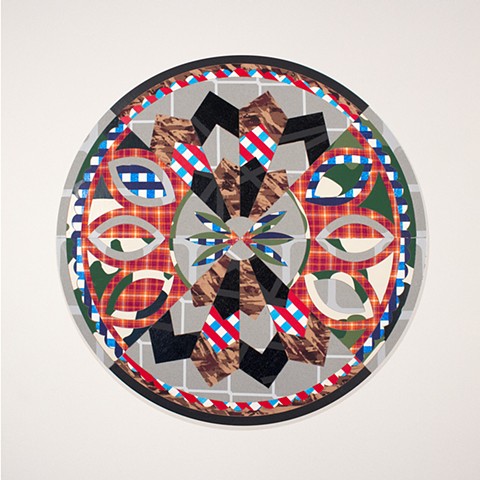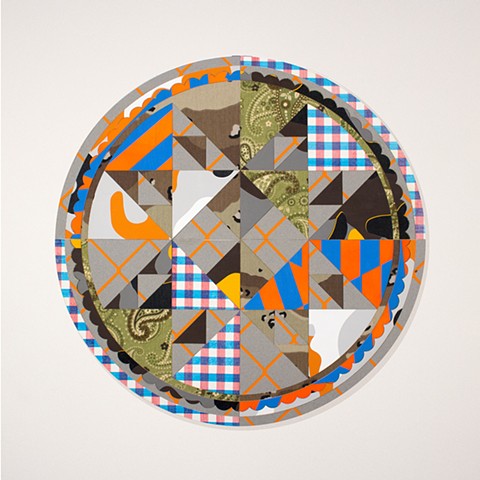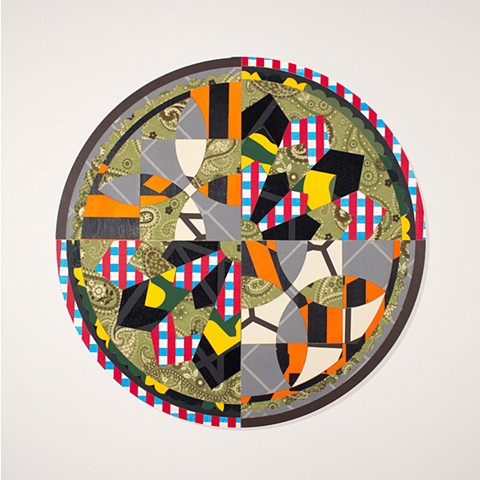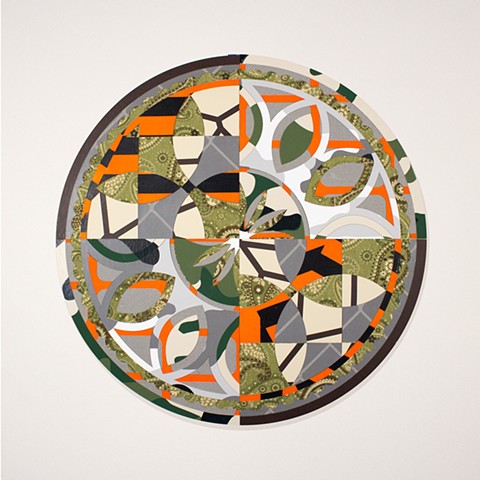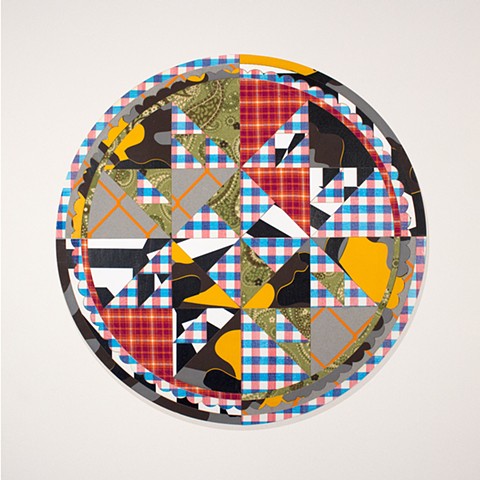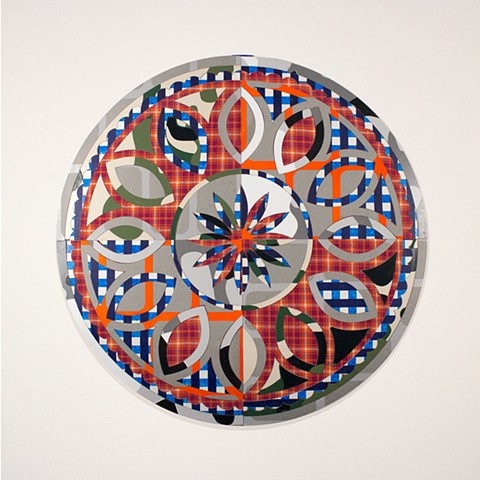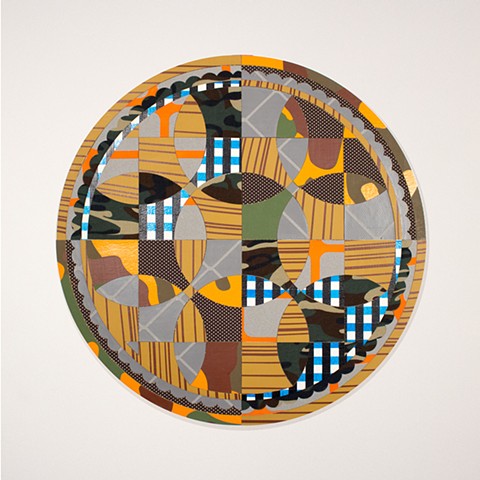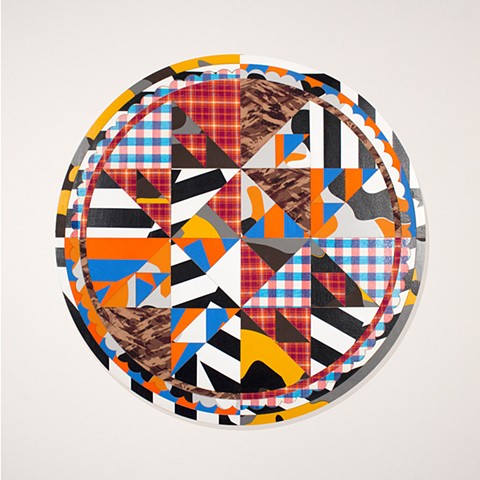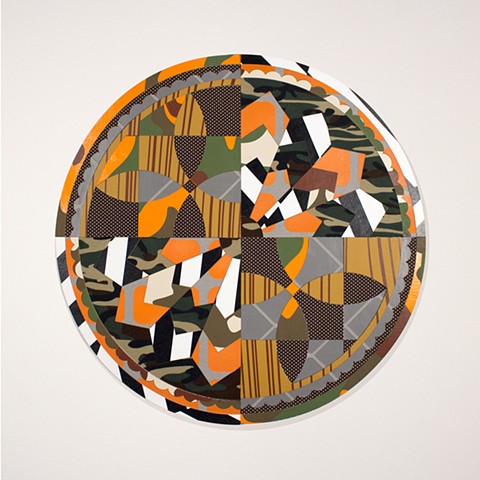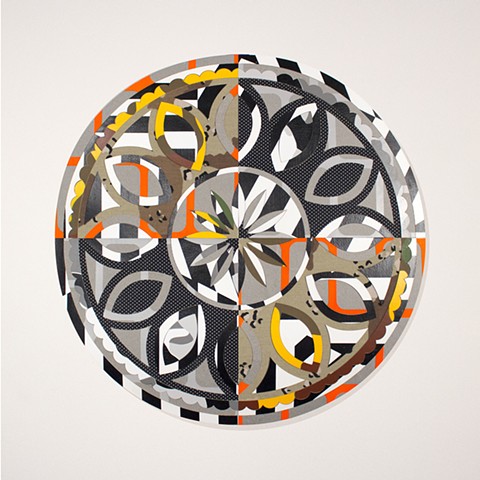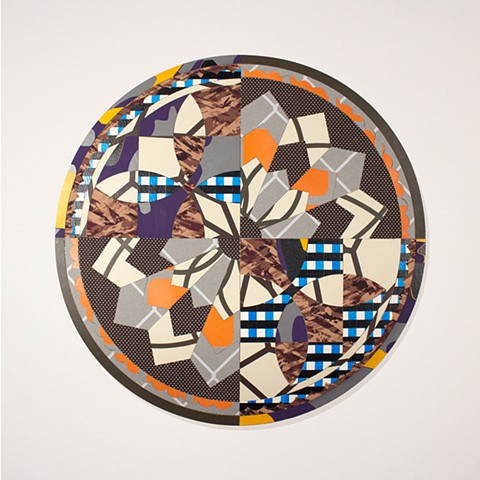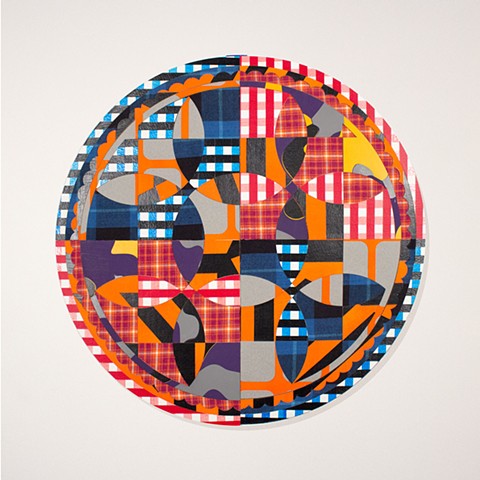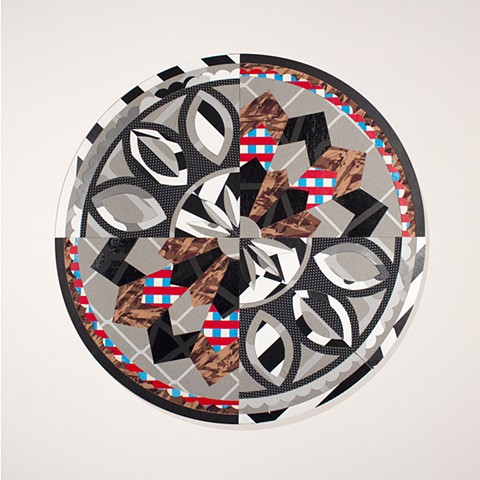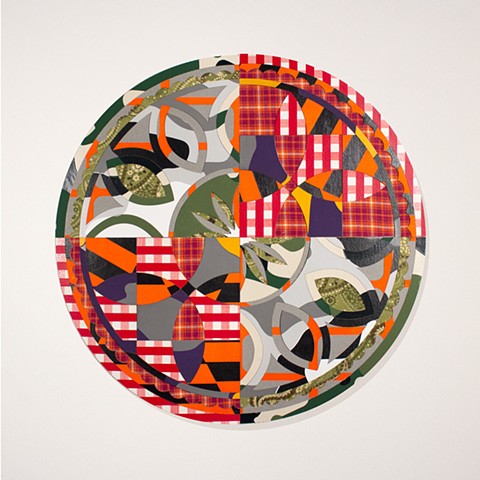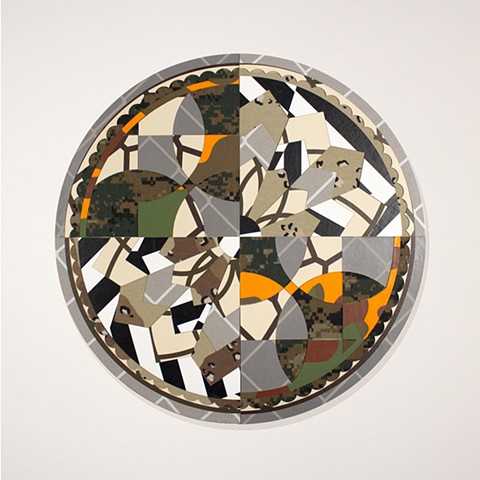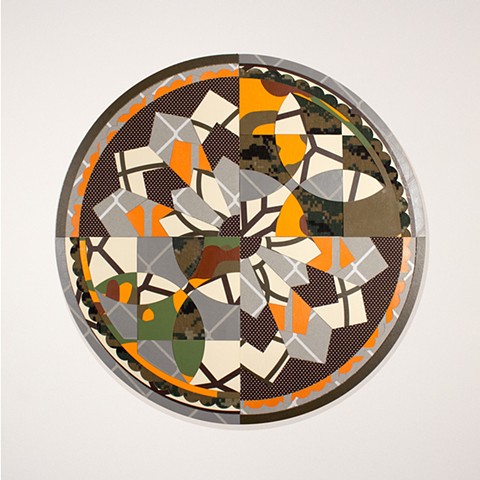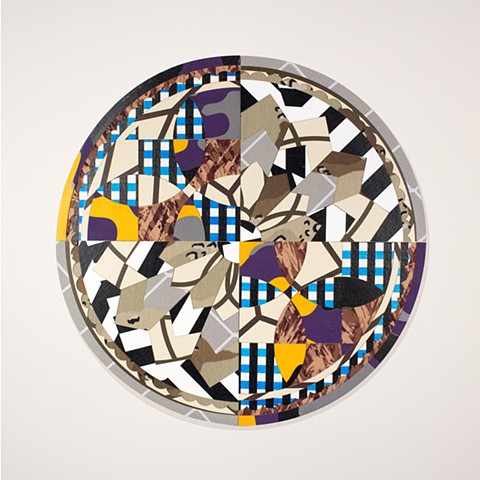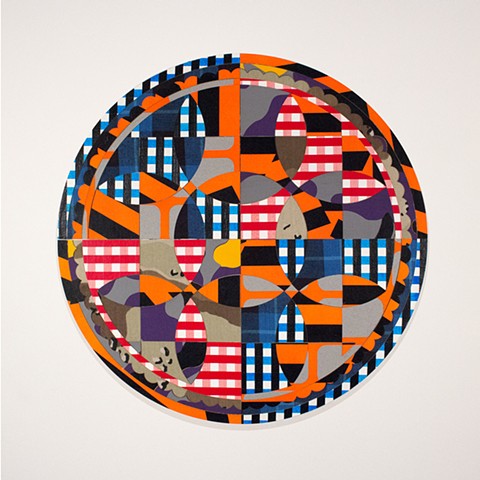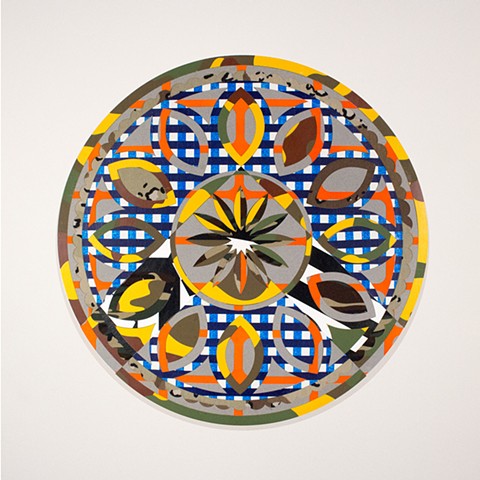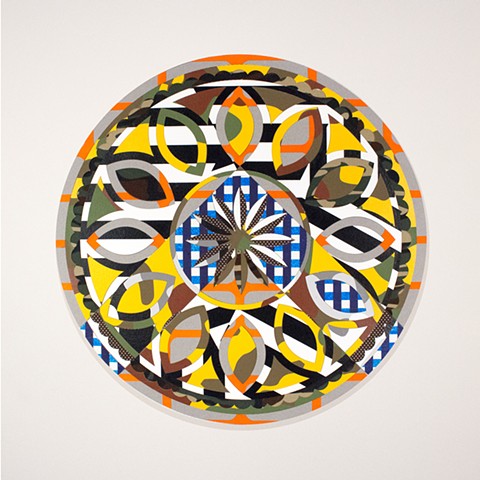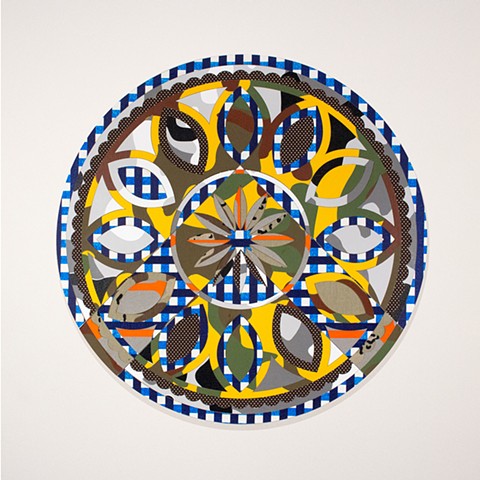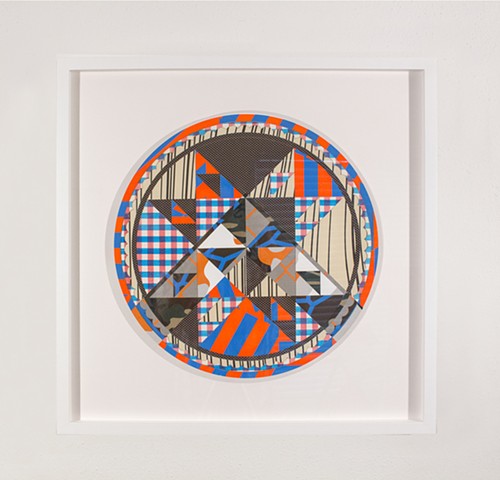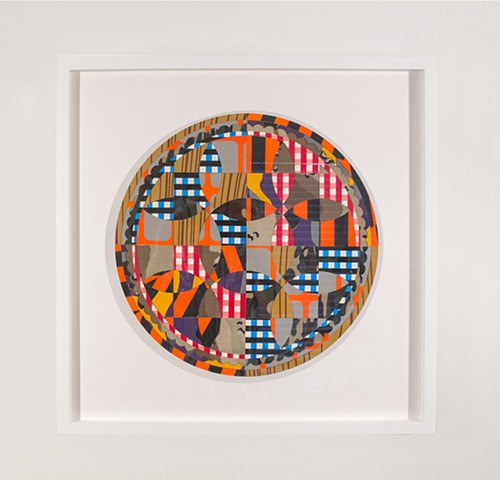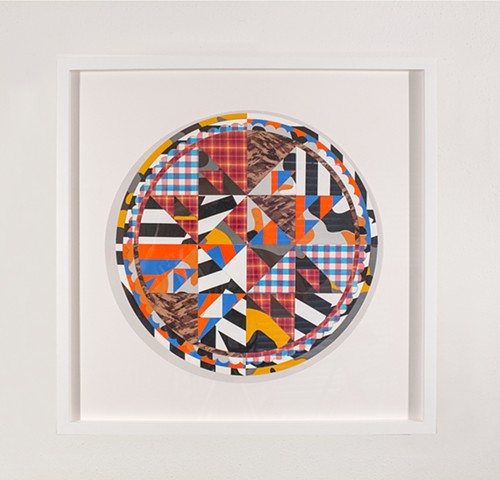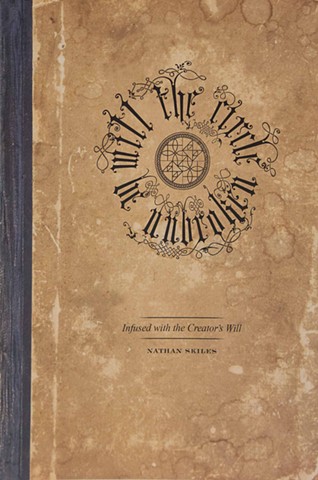Will the Circle Be Unbroken
WILL THE CIRCLE BE UNBROKEN
NATHAN SKILES
ESSAY BY
ANNE-MARIE RUSSELL
Nathan Skiles’ exquisite and beautiful tondo “paintings” are generative works, eminently texte scriptible, in the classic language of Barthes. As such, they are provocations which produce a rich delta of discourse with endless tributaries. The following traces but a few of those paths.
#theorizingtrompeloeil #beautifullosers #genuinesimulated #trompenottrump #papermoon
• Genuine Simulated •
When I was a teenager in my suburban Chicago(land) home in the 1980s, I had an otherwise unremarkable digital alarm clock with bright red glowing digits and a swooped design vaguely reminiscent of Gordon Bunshaft’s 1974 Solow Building. The alarm chirped in a particular way that attracted a pair of birds. Within a short time, the birds would gather on a branch outside my window and chirp in anticipation of the alarm (forgive me ornithologists, I know not which birds)*, eliminating the need for me to set the clock five minutes fast (a disorder sleep psychologists call a “crisis-maker alarm clock personality”, btw). Intriguing to birdsong experts, surely, but my interest lay elsewhere, in a small sticker on the back of the clock next to the “Made in Taiwan” mark. It read, earnestly and without a trace of irony, “Genuine Simulated Wood-Grain.” I gather there may have been some consumer protection legal issue regarding the potential treachery and trickery of deceiving customers into thinking they were acquiring an actual wood product that generated the need for such a declarative sticker, but in the interest of avoiding a research wormhole, I’ll leave us all wondering for now. My Dead Kennedys/Clash/ Black Flag inflected teen brain found this to be utterly, beautifully absurd, an apt metaphor for the cultural depravity, intellectual ennui and general existential threat posed by the suburban prison that constrained my existence, the boundaries of which were marked by endless strip malls, chain restaurants, “convenience” stores, country clubs and narrow minds. That little sticker summed it all up. And, I believe, set me on a trajectory of critical connoisseurship that has subsequently defined my professional activities. A perpetual quest for the real, the authentic, the true, the beautiful—or, failing that, a simulation so cock- sure that it frankly didn’t give a damn about fidelity. And this, my friend, is where we meet the work of Nathan Skiles...
BEST met in conversation, to preserve the artist’s voice, the following conversation is excerpted from a series of exchanges between Skiles and myself over a variety of devices, formats and media: vis a vis, tete text, email, phone and a panoply of social media formats, some of which will have expired by the time we go to press.
NES: Concerning the “Gen-yew-wine” simulated wood grain here’s a junk drawer of ideas.
Tired but true...“Imitation is the sincerest form of flattery that mediocrity can pay to greatness.” Where I might diverge from Wilde is that I believe it is through imitation that mediocrity finds a path to greatness. This is summed up perfectly in Dave Hickey’s essay Liberace: A Rhinestone as Big as the Ritz. While I can marvel over the old world craftsmanship of well-made furniture, I giddily revel in the adoration of a well made, but highly self-aware, simulation.
AMR: I suppose there is something paradoxically authentic in nakedly acknowledging a lie. That is why the logic of Las Vegas is impeccable, and why it’s easier to have sympathy for Vegas than wrath. It’s hard to be angry at something so open about its rejection of the cult of fidelity—or an acknowledgment of the lack of origin point, as in, fidelity to what? When? It’s almost like nostalgia, which of course is always misplaced. Perhaps it’s a very sophisticated position, almost an naive savant interpretation of the complexity of “truth” awash in a late capitalist, high corporatist, degenerate legacies of post-modern sea of ennui. And yet, I can’t shake it. I can’t let go of the notion, however disgraced, that there is a center, that there is truth, that there is a there there. But perhaps that’s just because we are having this discussion at a truly low point in our country. Or perhaps it’s the highest point? The pinnacle? The penultimate moment of absurdity just prior to a new order?
I mean, synthetic derivatives now being rebranded as “bespoke tranche opportunities?” The Donald? Really? I mean, whiskey tango foxtrot, godTM help us all. I can’t help but think we are doomed. But back to your art, which, by the way, brings me a great deal of relief in these trying times.
NES: I work best from a position of insecurity and Donald Trump’s presence in the media has been a clarion call to my creative practice. That said, as much as I might dislike Trump it’s the culture that embraces his jingoistic rhetoric that terrifies/galvanizes me the most.
I feel fortunate to be making work now, specifically in a time where pundits are preaching to a hungry flock about the need for magnificent walls. Recently there has been no greater creative fuel for me than the thought of the pivotal point where the parapet of a protective wall becomes the insurmountable boundary of a self-imposed prison.
Only the insecure need walls and symbols of protection.
AMR: Like hex signs?
NES: Like hex signs.
AMR: Your work is full of lies, lies told with no shame. In fact, the work screams “I’m lying! Can’t you see I’m lying? Why do you believe this? What makes you want to believe?” Your cuckoo clocks are gorgeous, silly, beautiful, seductive, charming, adorable, smart, whimsical, subversive, ridiculous, weird, compelling, cute (but not too) and troubling. And, yes, all at the same time. Oh, did I mention they are oddly anthropomorphic, too? Or at least, full of (cartoon) character. What are we to do with these menacing objects? These unholy, unheimlich things? They seem to have virtually no relation to an assemblage heritage, they are too deliberate, not random enough. But just how deliberate are they? For example, none of your clocks are set to “watch time”, that balanced, harmonious 10:10 that is always used to sell watches. What do the times mean? Are they random? Generated by compositional concerns? Or tied to some esoteric Knights Templar cult knowledge, the kind where, you could tell me,
but then you’d have to kill me...
NES: The times are not random. And yes, I’d have to kill you.
AMR: The tondos are also filled with lovely lies. The lie of/to the eye, trompe l’oeil. Let’s start with the camouflage. Camo has a first lie, an original sin—the fact that it’s painted to look like foliage. Later it was woven into fabric then printed onto fabric, then printed onto a variety of other mate- rials—vinyl, plastic, etc. Camouflage is literally a series of minor deceptions all based in the meta origin goal of trying to fool the eye by disappear- ing. The layers of complexity ontologically em- bedded in the concept of camouflage means that it’s overdetermined before it even makes its way into your work. Not to mention the overwhelming discourse of violence that first birthed the concept. Your choice of that material alone is a deliberate and powerful act. It’s not a found object, it’s a “found discourse”.
Tell me about your use of actual materials that reference other materials (i.e. camouflage fabric imitating foliage) versus your use of false materials (vinyl sticky) shaped to reference other materials (i.e. chain link fence), plaid, which is supposed to reference weaving, but is so far removed, etc. etc. The cognitive sticky wicket of physicality and reference with regard to materials...can you just download on that subject?
NES: I loathe literature that relies on stock, static characters, give me Heathcliff in all of his melodramatic complexity. All great things should be a complicated, mercurial stew of bitter sweetness. Along with the simulation the work should be grounded with an equal portion of concrete reality. Real camouflage, in all of its ersatz weirdness, paired with stylized but lovingly recreated replicas. What is, and what could be wed together in a perfect union of contradiction.
Being one step removed from reality, as a construct the simulation reeks of metaphor and becomes an overt signifier of the artist/designers affinity for a subject/material.
That said, my biggest fear in the studio has always been, “will people goggle over the quality of the simulation?” Too often discussions surrounding the work have focused entirely on the gee-whiz effect of the simulation and not on what was being simulated.
Order, justice, structure.
AMR: Without getting into the terribly interesting, complex and controversial origin and meaning of Pennsylvania Dutch hex signs, what do they mean to you? It’s so fascinating that we have no clarity or consensus on their origin, and that it is as likely that they began as “merely decorative”** and only later, by others, began to be imbued with notions of talismanic or supernatural powers, because it seems most things begin with a specific spiritual application or function which later gets lost when they are appropriated by others, so this is the opposite. Regardless, what do they mean to you?
NES: Concerning a parent’s desires for their progeny. The hex signs are a structure, a container to store the ingredients of desire and faith. Desire/ Faith against drought, and towards protection, prosperity, fertility, and the bountiful harvest.
Although I hold no belief in the supernatural, because the work so directly relates to talismanic objects it would be disingenuous not to approach the creation of each piece as an opportunity to imbue the object with faith. This is a hold over from the cuckoo clocks, where, like the famous rabbi of Prague, Judah Loew ben Bezalel, and the woodcarver Geppetto, I felt a strong urge to breath life into the inanimate and see it live as an extension of myself. The work also folds in mo- tifs from heraldry with the hope to double down on the twinned desire for protection and heritage.
Although it’s a bit cheesy, I love how pop fantasy writer Jim Butcher describes about the creation of magic potions.
He says something along the lines of this: Where a potion consists of eight parts: a base substance and seven ingredients; five ingredients
to engage each of the five physical senses, one to engage the mind, and one to engage the spirit. These ingredients are different for each potion and for each person who makes them. The potion must also be infused with the creator’s will.
AMR: Do you use this “formula” in your work?
NES: Not a formula, per se. But in order for you to make magic, you have to start by saying the words with intention, in an absolute way. But not too precisely, not without play. There needs to be a degree of specificity or rigor, but enough play to make it yours.
AMR: There is something menacing about your precision—much work that is too precise comes off as clinically cold and dead. But your sense of craft--and I mean that word in a very literal way knowing how apropos the origin of the word is your source material—is so keen, so skilled, so precise, that its very act seems imbued with a greater meaning or implication. I can’t quite place it but I sense that your precision is a siren call to the viewer to look more closely. It’s a seductive gambit that reels you in for a closer look.
NES: Craft for me is always meant to be a tone of voice, not the central point. Along that line, tying process to simulation, collage is the perfect means of construction. A straightforward painting might too seamlessly establish a simulation that might go unquestioned/unnoticed. Collage has the ability to immediately announce its means of construction, slyly positioning its greatest physical flaw, the blemished surface, as its most profound metaphoric virtue. As an artist, I want craft to function as a sly wink, nudge, or theatrical aside that knowingly embraces the viewer and slowly pulls them into the morass of subjects I’m less adept at discussing verbally.
AMR: Oh, I think you are doing just fine in terms of adeptness in speaking of your work, thank you. But yes, indeed, so much so-called craft and folk art has such an intelligent sense of humor, the sly wink you mentioned. You have talked about being brought up steeped in collective craft environments—quilting circles, knitting, crocheting, canning—group activities. It’s impossible to not read or apprehend this work without the specter of community, or at least the implication of an atmosphere of the commune, and yet your studio practice is very solitary, and you, well, how can I say this, you and I both are high-functioning curmudgeons who are pleasant enough, but given the choice, would probably prefer limited interactions with other human beings. Or who, at least, are not really “group activity” people. So how do you reconcile this contradiction? Or, to formulate a more effective question—how do you navigate the fundamental paradox of the human condition— navigating and negotiating self and other?
NES: Concerning the solitude of the studio, I think there are actually two issues to disentangle: the authority of the singular voice versus the communal voice, and the factual solitude of studio practice. Working with studio assistants has definitely reintroduced the communal aspect in my practice. Although I’m definitely the lead voice, we often share ideas, discuss politics and current events, and do a fair bit of gossiping.
Part of choosing to work within the boundaries of a craft is the introduction of the craft’s ruling voice. Although I’ll be the last person to join the stuffy confines of a craft society, I’m hoping to find humility in approaching each piece under the consideration of a tradition. This tradition ties me to a larger community.
Frankenstein’s monster is my favorite quilt; a perfect storm of aspiration and hubris. Less precision and more incision, both technically and stylistically; trim the unwanted fat and cobble the body back together from the choicest cuts.
AMR: Well that seems a fine place to leave off, considering that from the time you first uttered those words—when a viable Trump candidacy seemed as likely as a Kardashian candidacy—to now, when his nomination is all but secured, with the constant media references to him being a Frankenstein, the monster the GOP created and now cannot control. But I take solace in the fact that a Trump Presidency would all but guarantees a robust period of dynamic success from Nathan Skiles!
NES: Oh no, we can’t end there. It’s too tragic...
AMR: ...and since we love Frankenstein, it’s probably not fair to him to compare him to Trump, who is clearly no Promethean figure...
Though I am sure he is convinced he is giving us fire...or at least, ammunition...
NES: Agreed. The Trump character is no Promethean figure. Although it’s certainly not exclusive to the States, I can’t shake the feeling that we love and understand the underdog. And I don’t mean
a fairytale, storybook ending kind of scenario. I mean more of a deeply fallible loser made noble through earnest work.
I wanted to mention earlier about a piece of tape on the wall of the Perez Museum that had been painted over—not expertly, but lovingly— to simulate the speckled concrete behind it. More than anything I saw that day I was drawn to this simple form not because I saw through the facade and illusion but because the piece of vernacular material had been elevated and imbued with a simple earnestness and purpose.
I want to fill my life and studio with these beautiful losers and I want to place faith in their spirit in despite my distrust in the spiritual.
After all it’s only a paper moon.
•••••••
* Barnett Newman once said “Aesthetics is to artists as ornithology is to birds.” Reminding me of my irrelevance relative to artists.
** I had to put that in quotes to at least hint at how problematic and paradoxical that notion is, especially for someone who truly believes nothing is “merely” what it is—that a pipe is never just a pipe—but unpacking that notion is for another day, or at least another essay, indeed.
